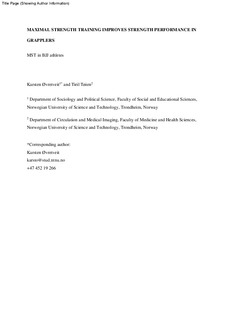| dc.contributor.author | Øvretveit, Karsten | |
| dc.contributor.author | Tøien, Tiril | |
| dc.date.accessioned | 2019-04-01T13:15:28Z | |
| dc.date.available | 2019-04-01T13:15:28Z | |
| dc.date.created | 2018-11-28T04:51:18Z | |
| dc.date.issued | 2018 | |
| dc.identifier.citation | Journal of Strength and Conditioning Research. 2018, 32 (12), 3326-3332. | nb_NO |
| dc.identifier.issn | 1064-8011 | |
| dc.identifier.uri | http://hdl.handle.net/11250/2592737 | |
| dc.description.abstract | The aim of this study was to assess the short-term effects of maximal strength training (MST) as an accessory to grappling training on strength performance in competitive Brazilian Jiu-Jitsu (BJJ) athletes. Fourteen male BJJ athletes underwent measurements of 1 repetition maximum (1RM) in the squat and bench press, rate of force development (RFD) and peak force (PF) in the squat jump, countermovement jump (CMJ) height, and muscular endurance in pull-ups, sit-ups, and push-ups. After baseline measurements, subjects were randomly allocated to either an MST group or control group (CON). The MST intervention consisted of 4 × 4 repetitions at ≥ 85% of 1RM in the squat and bench press, and 4 sets of pull-ups to failure, performed 3× per week. Both groups were instructed to maintain their BJJ training and avoid additional strength training. Maximal strength training improved 1RM in the squat and bench press by 15 ± 9% (p = 0.02) and 11 ± 3% (p = 0.03), respectively, and CMJ height by 9 ± 7% (p = 0.04). Muscular endurance performance increased by 33 ± 33% in pull-ups (p = 0.03), 32 ± 12% in push-ups (p = 0.03), and 13 ± 13% in sit-ups (p = 0.03). Increases in RFD (35 ± 55%, p = 0.13) and PF (8 ± 9%, p = 0.09) did not reach significance. No improvements were apparent from BJJ training alone (p > 0.05). These findings suggest that MST is a potent approach to rapid improvements in maximal strength, power, and muscular endurance in active grapplers. | nb_NO |
| dc.language.iso | eng | nb_NO |
| dc.publisher | Lippincott, Williams & Wilkins | nb_NO |
| dc.title | Maximal strength training improves strength performance in grapplers | nb_NO |
| dc.type | Journal article | nb_NO |
| dc.type | Peer reviewed | nb_NO |
| dc.description.version | acceptedVersion | nb_NO |
| dc.source.pagenumber | 3326-3332 | nb_NO |
| dc.source.volume | 32 | nb_NO |
| dc.source.journal | Journal of Strength and Conditioning Research | nb_NO |
| dc.source.issue | 12 | nb_NO |
| dc.identifier.doi | 10.1519/JSC.0000000000002863 | |
| dc.identifier.cristin | 1636055 | |
| dc.description.localcode | Copyright © 2018 by the National Strength & Conditioning Association. This is the authors' accepted and refereed manuscript to the article. Locked until 1.12.2019. The final authenticated version is available online at: https://journals.lww.com/nsca-jscr/fulltext/2018/12000/Maximal_Strength_Training_Improves_Strength.4.aspx | nb_NO |
| cristin.unitcode | 194,67,25,0 | |
| cristin.unitcode | 194,65,25,0 | |
| cristin.unitname | Institutt for sosiologi og statsvitenskap | |
| cristin.unitname | Institutt for sirkulasjon og bildediagnostikk | |
| cristin.ispublished | true | |
| cristin.fulltext | postprint | |
| cristin.qualitycode | 1 | |
